The exhibition features works by Chōbunsai Eishi (1756~1829) as well as his pupils.
It is on view at Chiba City Museum of Art from Jan. 6 to Mar. 3, 2024.
Prologue
From Shogunal Painting Attendant to Ukiyo-e Artist
Eishi was born as the first son in a well-off Hosoda family, direct retainers to the shogun. He succeeded to head of the family and worked for Shogun Ieharu as painting attendant, while Eishi learned painting from Kanō Eisen'in Michinobu (1730-90).
In 1786 Shogun Ieharu passed away, which contributed to saying good-bye to all the work for Ieharu to pursue art.
Eishi created his own original style of prints, mostly Bijin-ga portraits of tall, slender, and graceful beauties. He established his own school, where many pupils were born.
Though Eishi was an important Ukiyo-e artist, majority of his works unfortunately moved overseas during the Meiji Period.
You can see his works of his early days as an Ukiyo-e artist here.

Chōbunsai Eishi (1756~1829)
The Battle of Sekigahara
A part of handroll, ink and color on paper, titled "The Battle of Sekigahara"
Early Bunsei era (1818-30)
Nara Prefectural Museum of Art
Eishi depicted Fushimi Castle being burned down.
Chapter 1
Birth of the Sumida River Artist
Eishi debuted as a nishiki-e (multi-colored woodblock print) artist under better circumstances than contemporary star artists such as Utamaro and Hokusai. Eishi received much work on large-format and spectacular polyptychs (多層の), multi-part print.
You can see artworks that depict upper class women enjoying boating on the Sumida River.

Chōbunsai Eishi (1756~1829)
A Party of Ladies in a Pleasure Boat
Triptych (3枚続き絵画) of Color woodblock print
Museum of Fine Arts, Boston
William Sturgis Bigelow Collection 11.14119-21
A woman dancing with a fan on the bow is thought to symbolize Shizuka Gozen who is said to have danced at a Kamakura Hachimangu Shrine. And look at the woman in the center of the boat wearing a gorgeous kimono. She is thought to symbolize Minamoto no Yoshitsune. Eishi depicted him as a contemporary female.

Chōbunsai Eishi (1756~1829)
Gathering Clams
Triptych of color woodblock print
c. Tenmei 8- Kansei (1788-89)
Tabacco & Salt Museum
(On display until Feb.4)

Chōbunsai Eishi (1756~1829)
A Party in a Room of the Pleasure Quarters in Shinagawa
Triptych of color woodblock print
Museum of Fine Arts, Boston
William of Sturgis Bigelow Collection 11.14149-51
Eishi succeeded in conveying relaxed and vibrant atmosphere on the bright and colorful painting.
Chapter 2
Competing with Utamaro-Another Artist of Yoshiwara
Kitagawa Utamaro (1753~1806) was a competitor in bigin-ga(pictures of beauties). He got a great popularity with his Bijin Okubi-e, bust portraits of beautiful women, with a delicate and elegant touch, while Eishi depicted graceful, tall, and slender standing beauties, which he got great fame as well.
Here you can see artworks depicting courtesans of pleasure houses in grace tone.

Chōbunsai Eishi (1756~1829)
The Courtesan Somenosuke of the Matsubaya House with her attendants' names Wakaki and Wakaba, from the series New Year Fashions as Fresh as Young Leaves
Color woodblock print
鳥文斎栄之《若菜初衣裳松葉屋 染之助 わかき わかば》大判錦絵 寛政6年(1794)頃 ボストン美術館蔵
Museum of Fine Arts, Boston. William Sturgis Bigelow Collection 11.14082
Photograph © 2023 Museum of Fine Arts, Boston
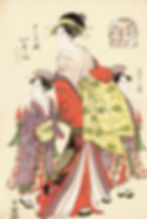
Chōbunsai Eishi (1756~1829)
The Courtesan Isoyama of the Chōjiya House with her attendants Kichiji and Takiji, from the series New Year Fashions as Fresh as Young Leaves
Color woodblock print
Kansei 7 (1795)
鳥文斎栄之《若那初模様 丁子屋 いそ山 きちじ たきじ》大判錦絵 寛政7年(1795)頃 ボストン美術館蔵
Museum of Fine Arts, Boston. William Sturgis Bigelow Collection 11.14036
Photograph © 2023 Museum of Fine Arts, Boston
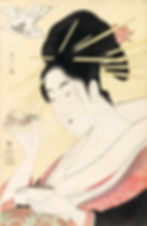
Chōbunsai Eishi (1756~1829)
A Selection of Six Flowers - A Parody Rokkasen: Priest Kisen
Color woodblock print
c. Kansei 8-10 (1796-98)
The British Museum
鳥文斎栄之《畧六花撰 喜撰法師》大判錦絵 寛政8−10年(1796-98)頃 大英博物館蔵
The British Museum, 1927,0518,0.5 © The Trustees of the British Museum. All rights reserved.

Chōbunsai Eishi (1756~1829)
Three Beauties with a hanging Scroll of Calligraphy
Color woodblock print
c. Kansei 4-5 (1792-93)
鳥文斎栄之《松竹梅三美人》大判錦絵 寛政4-5年(1792-93)頃 ボストン美術館蔵
Museum of Fine Arts, Boston. William Sturgis Bigelow Collection 11.14079
Photograph © 2023 Museum of Fine Arts, Boston
Chapter 3
Elegance of the Colors-Nishiki-e with a Hint of Red
Around 1781 to 1801, Nishiki-e (color woodblock print) publishing world flourished, when numerous star artists appeared and it was common to use bright colors such as red to produce Nishiki-e. Eishi took an opposing reaction and mostly used purple in subdued tones, which contributed to the harmony with the artworks on themes from classical literature.

Chōbunsai Eishi (1756~1829)
Asagao, from the series Genji in Fashionable modern Guise
Triptych of color woodblock prints
The British Museum
Eishi depicted various elements of the story scattered across one picture.

Chōbunsai Eishi (1756~1829)
The Tale of Ise
Triptych of color woodblock prints, ink and color
c. Kansei 3-4 (1791-92)
The British Museum
Eishi illustrated episodes from the Heian-Period (794-1185) poem story.
Chapter 4
The Unique World of Eishi
Since Eishi was born in samurai family and he had seen real life of samurai, he produced artworks portraying the manners and customs of noble women to the request of publisher.
Eishi's Bijin-ga fasinated not only upper-class people but also common people, because his works are full of grace. Samurai or upper-class people would buy Eishi's picture, feeling familiarity, while common people would peek at the world of wealthy samurai that they had never seen before.
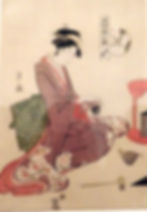
Chōbunsai Eishi (1756~1829)
Tea Ceremony, from the series parodies of the Six Arts in Fashionable Guise
Color Woodblock print
c. Kansei 5-6 (1793-94)
Chiba City of Museum of Art

Chōbunsai Eishi (1756~1829)
Hotei, from the series A Comparison of the Treasures of the Gods of Good Fortune
Color Woodblock Print
c. Kansei 5-6 (1793-94)
Tokyo National Museum
(On display until Feb.4)
This print parodies the Seven Gods of Fortune as contemporary beauties.
Chapter 5
Success of Eishi's pupils
Eishi had many pupils. Nothing about the origins of Eisho, Eiri, and Eisui are known.
It is said that they were from samurai families, so they might hesitate to declare that they were ukiyo-e artists.

Chōkōsai Eishō (the date of birth and death unknown)
Parody of the tale of Jōruri in twelve Chapters
Triptych of color woodblock print
The middle of Kansei era (1789-1801)
Chiba City Museum of Art

Chōkyōsai Eiri (the date of birth and death unknown)
Autumn Moon at Ishiyama Temple: Hinazuru of the Chōjiya House with her attendants' names Tsuruji and Tsuruno, from an untitled series of Courtesans for the Eight Views of Ōmi
Color woodblock print
c. Kansei 7 (1795)
Museum of Fine Arts, Boston
William Sturgis Bigelow Collection 11.15008
Photograph © 2023 Museum of Fine Arts, Boston
Eiri depicted Hinazuru likened to Murasaki Shikibu who was in thought with her elbow on a desk. Murasakishikibu is said to have written "The Tale of Genji" at Ishiyama Temple.
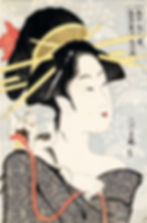
Chōkosai Eisho (the date of birth and death unknown)
The Courtesan Motozue of the Daimonjiya House, from the series Contest of Beauties of the Pleasure Quarters
Color woodblock print, c. Kansei 9 (1797)
Museum of Fine Arts, Boston
William Sturgis Bigelow Collection 11.21185
Photograph © 2023 Museum of Fine Arts, Boston
Eisho depicted a charming beauty smiling gracefully with a naughty cat on the shoulder.
Chapter 6
Cultural Circles around Eishi
Many groups of kyōka lovers appeared at the end of Tenmei (1781-89). Color-printed illustrated kyōka books were published for citizens and private publications called 'surimono' were also printed. Eishi incorporated town people's culture and illustrated kyōka books.

Chōkosai Eishō (the date of birth and death unknown)
Print for New Year's Morning: Annual Ceremony
Kansei 9 (1797)
Edo Tokyo Museum
(On disply until Feb.4)
Eishō depicted a man in samurai dress with a short sword to offer New Year Greetings.
He seemed to be a towns man.
Chapter 7
The Ultimate in Beauty - Ukiyo-e Paintings
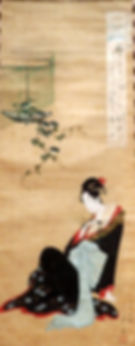
Chōbunsai Eishi (1756~1829)
Beauty with Bellflowers
Hanging scroll, ink and color on silk
Kansei 7 (1795)
Chiba City Museum of Art
This is a representative work of Eishi's hand-painted ukiyo-e.

Chōbunsai Eishi (1756~1829)
Three Gods of Good Fortune Visiting Yoshiwara
Handscroll, ink and color on silk
Early Bunsei era (1818-30)
Chiba City Museum of Art
You can see three gods of good fortune, Fukurokuju, Daikoku, and Ebisu from the left.
Eishi humorously portrayed the gods being entertained by courtesans at Yoshiwara.
Epilogue
An Artist Admired by Collectors Abroad
Since Eishi's works were so much acclaimed during Japonisme movement that many of his works crossed overseas, there aren't many works of his in Japan now.
You can see displays of auction catalogues of Eishi and his pupils.

This is from the auction catalogue published in 1920 for the Arnold Genthe Collection.
source: catalogue published by Chiba City Museum of Art
More information, please access here